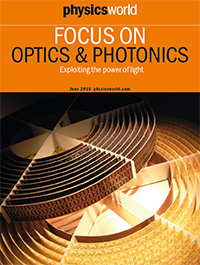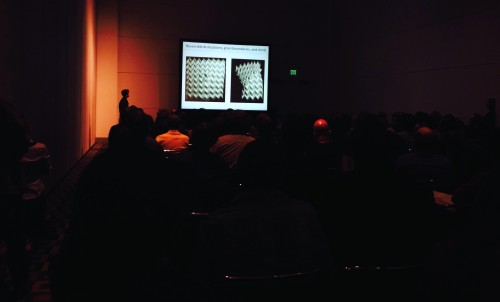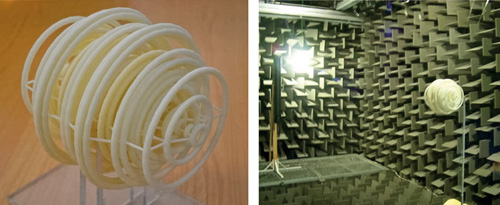Tag archives: metamaterial
Physics World 2016 Focus on Optics and Photonics is out now
 By Matin Durrani
By Matin Durrani
Research into optics, photonics and lasers is not only fascinating from a fundamental point of view. It’s also vital for technology, industry and applications in everyday life.
In the latest focus issue of Physics World, which is out now in print, online and through the Physics World app, you can find out about some of the latest research into optics and photonics – and how it’s being put to good use.
In our cover feature, take a look at some of the latest advances in invisibility cloaking – 10 years after first being demonstrated at microwave frequencies.
View all posts by this author | View this author's profile
LEGO bricks, bony foams and Islamic art aid metamaterial advances

Play time: Paolo Celli with his LEGO platform. (Courtesy: Tushna Commissariat)
By Tushna Commissariat in Baltimore, Maryland, US
Metamaterials are always a hot topic at the APS March meetings, and this afternoon we were treated to an array of the latest developments in the field. Just in case you have not come across the term before, a metamaterial is an artificially crafted material that aims to achieve the naturally unattainable. These materials are engineered to have special physical properties – some metamaterials act as optical or acoustic cloaks, while some can harvest energy or be used to dissipate it in some form.
Paolo Celli of the University of Minnesota in the US loved playing with LEGO bricks as a child. Now, the physicist still gets to play with LEGO, as his team has been using the bricks both to understand how metamaterials interact with waves and also as an inexpensive and accessible outreach medium. While the researchers initially looked at 3D printing to develop their platform material, they soon found that LEGO bricks attached to a baseplate made for an agile, versatile, low-cost platform that was not highly damped and could be easily reconfigured.
Celli and colleagues have already used the LEGO to experimentally demonstrate phononic band gaps and the associated energy-trapping mechanisms. They are currently working on demonstrating the control of wavelengths that are larger than the width of waveguides realized in the brick pattern, with potential applications in subwavelength wave focusing and imaging. We will be talking to Celli tomorrow, so watch out for more on LEGO metamaterials soon.
View all posts by this author | View this author's profile
Snip and tuck

A rapt audience watches Silverberg’s presentation on origami.
By Tushna Commissariat at the APS March Meeting in Denver
Origami – the traditional Japanese art of paper folding – has long intrigued mathematicians and physicists alike. In addition to understanding the mechanics of it, its principles have been applied to the folding of DNA and other nanoscale structural designing, as well as in the folding of rigid sheets using hinges. Indeed, the latter is used for a variety of purposes: from the simple folds of a paper bag with a flat bottom to the folding of airbags and telescopes, and even to simulating the folding of large solar panels for space satellites (known as the Miura fold, named after its inventor the Japanese astrophysicist Koryo Miura).
This morning, I went along to an APS session that looked at “extreme mechanics”, where researchers were talking about the origami and kirigami – a version of origami that involves folding and making small cuts to a single sheet of paper – of structural metamaterials.
View all posts by this author | View this author's profile
How to survive earthquakes and noisy neighbours
By Jon Cartwright
The past few years has seen a steady stream of proposals for cloaking objects, whether it’s from light, heat, water waves, magnetic fields or even time. Now, physicist Sang-Hoon Kim at the Mokpo National Maritime University in Korea is adding to this list, first off with a cloak that could protect buildings from earthquakes.
An earthquake cloak has been proposed before using – as is common in invisibility cloaks – elaborately structured “metamaterials” to guide seismic waves safely around a building. However, Kim, together with Mukunda Das at the Australian National University in Canberra, has put forward a different approach: a metamaterial barrier that dissipates seismic energy as sound and heat. The idea is that many buildings could hide in the “shadow zone” of the barrier. This could be a boon for city planners, who would not have to make cloaks for individual buildings. Kim and Das’s paper has been accepted for publication in Modern Physics Letters B and is available as a preprint entitled “Artificial seismic shadow zone by acoustic metamaterials“.
View all posts by this author | View this author's profile
Surround no sound?
By Tushna Commissariat

A picture of the 3D acoustic cloak (left) and the cloak being tested in an anechoic chamber (right). (Courtesy: Physical Review Letters)
Invisibility cloaks seem to fascinate scientists and the public in equal measure, and every few months a novel design for some sort of metamaterial that cloaks either light or sound catches our eye, if you excuse the pun.
This week, we came across a group of researchers in Spain that claims to have designed, fabricated and tested the first “directional 3D acoustic cloak” that works for airborne sound. Previous designs of acoustic cloak work in water and air, but only if the sound propagates in 2D. Also, many cloaks only work within a narrow band of frequencies, limiting their uses.
View all posts by this author | View this author's profile